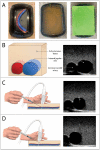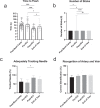Longitudinal trends using a point-of-care gelatin-based model for ultrasound-guided central venous catheter insertion
- PMID: 33960914
- PMCID: PMC8118402
- DOI: 10.1080/10872981.2021.1924350
Longitudinal trends using a point-of-care gelatin-based model for ultrasound-guided central venous catheter insertion
Abstract
Ultrasound (US)-guided central venous catheter (CVC) insertion is a procedure that carries the risk of significant complications. Simulation provides a safe learning atmosphere, but most CVC simulators are not available outside of simulation centers. To explore longitudinal trends in US-guided CVC insertion competency in internal medicine (IM) interns, we studied the use of a low-fidelity, gelatin-based, US-guided CVC insertion simulation model combined with a simulation curriculum. This prospective observational study of IM interns was performed over the course of one academic year. Interns (n = 56) underwent model-based, US-guided procedure simulation training program and a repeated training course prior to their intensive care unit (ICU) rotation. CVC insertion competency at different timepoints was recorded. Survey data about intern experience and attitudes were also collected. Out of the 56 interns initially trained, 40 were included in the final analysis. Across all outcomes, interns experienced skill atrophy between initial training and the beginning of their ICU month. However, by the end of the month, there was a significant improvement in competency as compared to initial procedural training, which then waned by the end of the intern year. Attitudes toward the model were generally positive and self-reported confidence improved throughout the course of the year and correlated with objective measures of competency. Over the course of their intern year, which included simulation training using a gelatin-based model, interns demonstrated consistent competency trends. The use of a gelatin-based CVC insertion simulation model warrants further study as an adjunctive aid to existing simulation training.
Keywords: Simulation training; central venous catheters; gelatin; internal medicine; medical education; point-of-care ultrasound.
Conflict of interest statement
No potential conflict of interest was reported by the author(s).
Figures




References
-
- Kusminsky RE. Complications of central venous catheterization. J Am Coll Surg. 2007;204:681–10. - PubMed
-
- American college of physicians: about medical procedures required during residency training. [cited 2020 November5]. Available from: https://www.acponline.org/about-acp/about-internal-medicine/career-paths...
-
- Sherertz RJ, Ely EW, Westbrook DM, et al. Education of physicians-in-training can decrease the risk for vascular catheter infection. Ann Intern Med. 2000;132:641–648. - PubMed
-
- Martin M, Scalabrini B, Rioux A, et al. Training fourth-year medical students in critical invasive skills improves subsequent patient safety. Am Surg. 2003;69:437–440. - PubMed
Publication types
MeSH terms
Substances
LinkOut - more resources
Full Text Sources
Other Literature Sources
